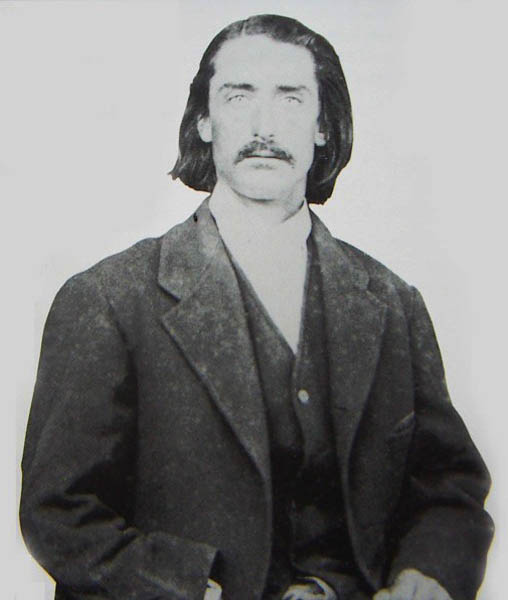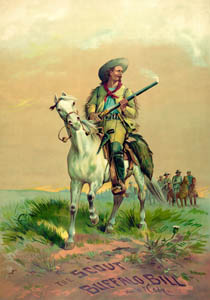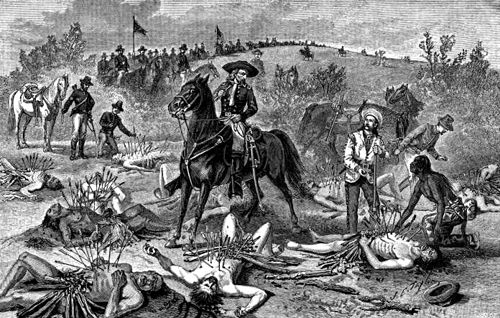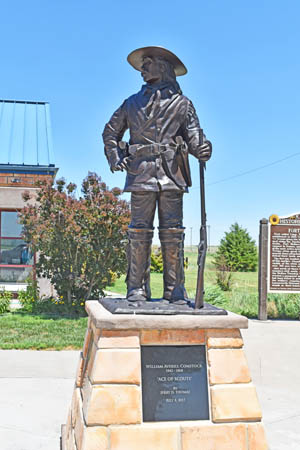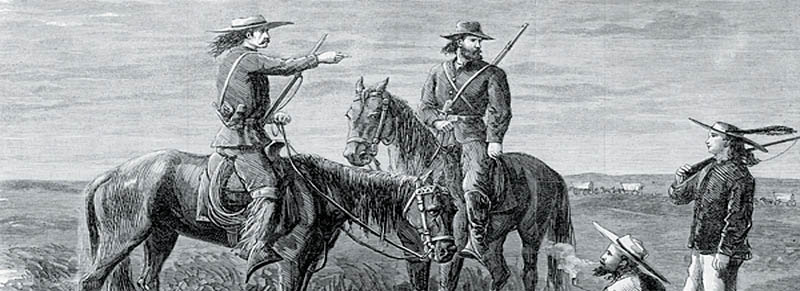
Army scouts on the Great Plains.
William Comstock, a scout on the central plains in the days of the Old West, was celebrated by contemporaries for his skills but was killed in the line of duty.
William Averill Comstock was born in Comstock, Michigan on January 17, 1842, to Horace and Sarah Cooper Comstock. The town was named for his father, Horace Hawkins Comstock, who was a prominent lawyer and the first senator to be elected from Kalamazoo County in 1835. His mother Sarah was from New York and was a niece of the novelist James Fenimore Cooper. Unfortunately, William’s mother died when he was just four years old. In the next years, his father married three more times. Young William lived with his father but eventually ended up in Wisconsin under the care of his older sister Sabina.
Though he had little formal education, he was inspired by tales of adventure written by his great uncle James Fenimore Cooper. He headed west at an early age and was working as an Indian trader in Cottonwood Springs, Nebraska Territory in 1860. He soon earned a reputation as an Indian scout and guide.
Learning to speak several Indian languages, he became the chief of scouts and interpreter at Fort Wallace, Kansas. He was the favorite scout of General Phil Sheridan and General Armstrong Custer and became nationally known as the “Ace of Scouts.” Because of his prowess with a rifle, he also had earned the title of “Buffalo Bill.”
“No Indian knew the country more thoroughly than did Comstock. He was perfectly familiar with every divide, watercourse, and strip of timber for hundreds of miles in either direction. He knew the dress and peculiarities of every Indian tribe, and spoke the language of many of them.” — General George Armstrong Custer, in his book My Life on the Plains
Comstock was known as “Medicine Bill” among some of his companions primarily because of his superstitious nature. However, the Indians, called him “Medicine Bill” because Comstock had cut off a man’s finger to save him from a rattlesnake bite.
In the fall of 1865, Comstock scouted briefly for the Army at Fort Halleck, Wyoming, before moving to western Kansas, settling on what came to be known as Rose Creek Ranch. The scout sold hay to Fort Wallace. By 1866, he was the chief of scouts at Fort Wallace, the westernmost post on the Smoky Hill Trail in Kansas.
When the title of “Buffalo Bill” was disputed, a hunt was arranged between Comstock and “Buffalo Bill” Cody near Monument, Kansas. The prize for the horseback buffalo-hunting contest was $500 and the winner claim the title “Buffalo Bill.” Cody apparently won the contest, killing 69 bison to Comstock’s 46.
“Billy Comstock… had the reputation, for a long time, of being a most successful buffalo hunter, and the officers in particular, who had seen him kill buffaloes, were very desirous of backing him in a match against me.” — Buffalo Bill Cody
Others shared Custer’s opinion, and Comstock’s services were always in demand. In the spring of 1867, Comstock accompanied Custer’s 7th U.S. Cavalry into the field under Major General Winfield Scott Hancock, whose search to find hostile Cheyenne warriors. In fact, his presence with the command prevented what could have led to the deaths of Custer, Hancock, and many of the troops who accompanied them in the summer of 1867 in what was called “Hancock’s War.” At this time, Comstock stopped the troops from heading into an ambush led by half-breed Cheyenne interpreter George Bent, who was angry about the Sand Creek Massacre that had occurred in 1864. Comstock’s knowledge of languages and the ways of the Indians circumvented the ambush.
Comstock further distinguished himself, when he found the mutilated remains of an 11-man detachment under Lieutenant Lyman Kidder that vanished in early July while carrying orders to Custer in the field. Kidder Massacre occurred near present-day Goodland, Kansas, on July 2, 1867. The troops had been the victims of Cheyenne Dog Soldiers and Sioux.
William was described as a man of few words with an even disposition, knowledgeable in numerous subjects, fearless, unassuming, and a perfect gentleman. However, he was not immune to gunplay. Early in 1868, after a contractor named H.P. Wyatt refused to pay him for a job, Comstock challenged him to a duel at the post trader’s store. Though the two men drew their guns at the same time, Comstock fired four shots before Weightman ever pulled the trigger. Afterward, William was arrested and pleaded guilty to shooting Wyatt, but the judge dismissed the case.
“He was a man of mystery and contradictions, but all who knew him agreed about his appearance: small in stature, wiry as whip leather and dark in coloring, with long hair tucked beneath a wide-brimmed sombrero and eyes that could pierce like an arrowhead.” W.E. Webb, Harper’s New Monthly Magazine, November 1875
The Indians started making trouble again in the summer of 1868. General Phil Sheridan, who had replaced Hancock as commander of the Department of the Missouri, ordered Lieutenant Frederick Beecher to assemble a team of scouts to keep tabs on the hostiles and negotiate with them if necessary. Beecher hired four men including Dick Parr, Frank Espey, Abner “Sharp” Grover, and Comstock.
In August, Comstock and Abner Grover, were ordered by Lieutenant Beecher to go to the camp of the Cheyenne Chief Turkey Leg to try to rein in his warriors, who were wreaking havoc in the Saline Valley and along the Solomon and Republican Rivers. Both men had lived with the chief during their trading days and had high expectations. However, when they arrived in the village on August 16, the meeting was tense. The Indians then drove the scouts from the village on August 18. However, when they were just about two miles away, they were overtaken by seven Indians, who at first appeared friendly. However, the native soon fired on Comstock and Grover and left them for dead. Grover, however, survived and made his way to the railroad. Upon arriving at Fort Wallace, Comstock’s body was recovered and buried at the old Fort Wallace Post Cemetery, but the location is unknown today. Comstock was just 26 years old.
However, others thought that Comstock was killed by fellow scout Abner Grover, who soon took over his profitable Rose Creek Ranch. Grover was killed in a drunken saloon brawl in 1869. His assailant was not charged, alleging that he acted in self-defense.
Also See:
Indian Wars, Battles & Massacres
Indian Wars of the Frontier West
Sources:

